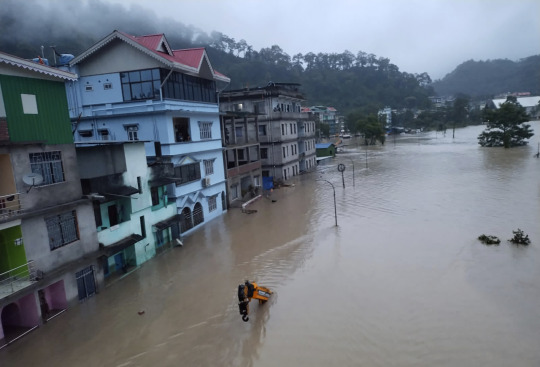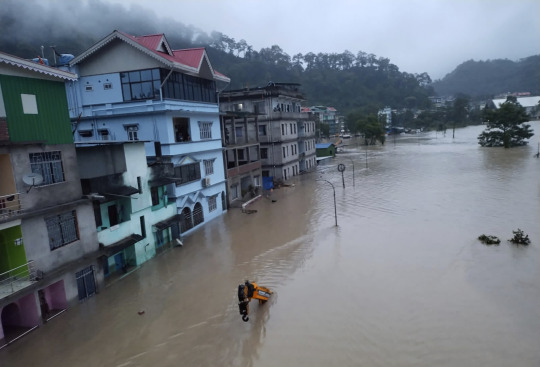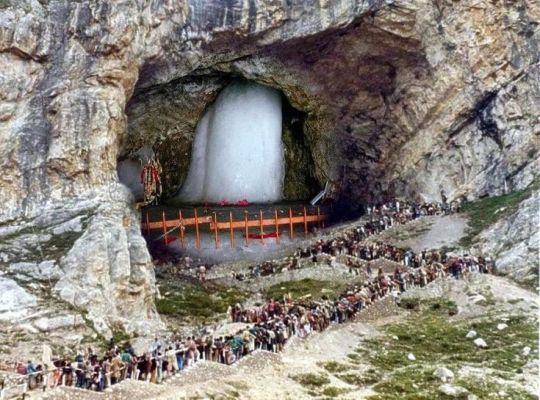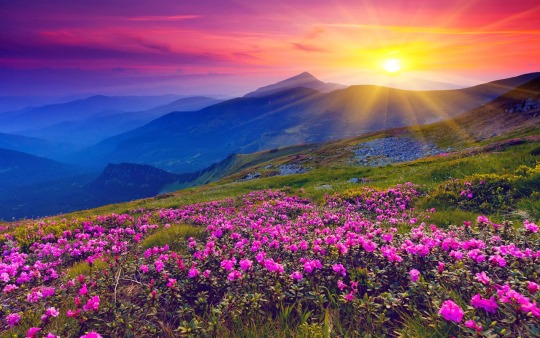#sikkim cloud burst
Text
Sikkim floods: At least 14 people dead and 23 soldiers among dozens missing after freak ‘cloud burst’ storm breaches dam | In Trend Today
Sikkim floods: At least 14 people dead and 23 soldiers among dozens missing after freak ‘cloud burst’ storm breaches dam
Read Full Text
or
Full Article on MAG NEWS

View On WordPress
#Celebrities#Money#Motors#Politics#ShowBiz#Sikkim floods: At least 14 people dead and 23 soldiers among dozens missing after freak ‘cloud burst’ storm breaches dam#Sport#Tech#UK#US#World
0 notes
Text
Sikkim में बादल फटने से तबाही, दो पुल बहे, सेना के 23 जवान लापता
Gangtok: नार्थ सिक्किम में ल्होनक झील पर बादल फटने (Cloud burst on Lhonak Lake in North Sikkim) से भारी तबाही हुई है। इस वजह से लाचेन घाटी में तीस्ता नदी का जलस्तर अचानक बढ़ गया है।
इस बाढ़ में सेना के 23 जवानों के लापता होने की आशंका है (23 army personnel are feared missing)। यह सूचना असम की राजधानी गुवाहाटी में रक्षा मंत्रालय के जनसंपर्क अधिकारी ने एक्स हैंडल पर साझा की है।
जनसंपर्क अधिकारी…

View On WordPress
#23 army personnel are feared missing#caused huge devastation#Cloud burst on Lhonak Lake#North Sikkim#Sikkim News
0 notes
Text
Sikkim floods: At least 14 people dead and 23 soldiers among dozens missing after freak ‘cloud burst’ storm breaches dam
Sikkim floods: At least 14 people dead and 23 soldiers among dozens missing after freak ‘cloud burst’ storm breaches dam
Read Full Text

View On WordPress
0 notes
Text
Unraveling the Mystery: Unveiling the Culprits Behind the Devastation in Sikkim - A Costly Warning Ignored?
Cloud Burst Incident in Sikkim Leaves 14 Dead, 26 Injured, and 102 Missing, Including 22 Army Personnel
The recent cloud burst incident in Sikkim has resulted in a devastating loss of life and destruction. The risk of glacier melting, which can be attributed to climate change, has been increasing. This, in turn, has led to the possibility of more disasters occurring. The attention has now turned…

View On WordPress
0 notes
Text
Unraveling the Mystery: Unveiling the Culprits Behind the Devastation in Sikkim - A Costly Warning Ignored?
Cloud Burst Incident in Sikkim Leaves 14 Dead, 26 Injured, and 102 Missing, Including 22 Army Personnel
The recent cloud burst incident in Sikkim has resulted in a devastating loss of life and destruction. The risk of glacier melting, which can be attributed to climate change, has been increasing. This, in turn, has led to the possibility of more disasters occurring. The attention has now turned…

View On WordPress
0 notes
Text
Sikkim floods: At least 14 people dead and 23 soldiers among dozens missing after freak ‘cloud burst’ storm breaches dam
Sikkim floods: At least 14 people dead and 23 soldiers among dozens missing after freak ‘cloud burst’ storm breaches dam
Read Full Text

View On WordPress
0 notes
Text

गंगटोक (एएनआई)। Sikkim Cloud Burst : उत्तरी सिक्किम में लोनाक झील के ऊपर अचानक बादल फटने के कारण लाचेन घाटी की तीस्ता नदी में बाढ़ आ गयी। इस बाढ़ में सेना के 23 जवानों के लापता हो गए हैं। र���्षा जनसंपर्क अधिकारी (पीआरओ) गुवाहाटी ने एक्स पर घटना के बारे में जानकारी दी और पोस्ट किया, उत्तरी सिक्किम में लोनाक झील पर अचानक बादल फटने के बाद लाचेन घाटी में तीस्ता नदी में अचानक आई बाढ़ के कारण 23 सेना के जवानों के लापता होने की सूचना मिली है
0 notes
Photo

Cloud burst occurred at lower Amarnath Holy Cave at around 5:30pm today. Rescue teams rushed. Three langars washed away due to heavy flow of water . Few people reportedly missing. ITBP, J&K Police, Indian Army and others involved in rescue ops. #AmarnathYatra https://t.co/SkZL91jHcN (at Melli , Bazaar, South Sikkim, India) https://www.instagram.com/p/CfwcLaQv-Xy/?igshid=NGJjMDIxMWI=
0 notes
Text
Let’s Instagram this moment
The natural beauty of these locations has made them a favourite with Indian as well as foreign tourists. Their popularity can be judged not just by the annual footfall but also by their constant presence on Instagram. Social media, today, provides a good reflection of a trend — travel or otherwise. No wonder then, these stunning places are among the most-Instagrammed destinations on desi shores.
Ladakh:

Whether you are a photographer or not, rest assured that you will have many frame-worthy pictures when you return from a sojourn to this scenic place. Unsurprisingly, it’s a huge hit with Instagrammers. With many accounts dedicated to this very destination, the fan club only keeps growing. Among the most picturesque places here are Pangong Lake, Hunder, Kardungla Pass, Tsomoriri Lake, and Chandrataal Lake among others. :
Kodaikanal:

At the mention of Kodaikanal, you think of its wonderful climate, cliffs covered in mist, cloud-capped mountains and beautiful lakes and valleys. Known as the Princess of Hill Stations, it also offers tourists manicured slopes, scenic waterfalls and hills, which make it the perfect mountain getaway. Jaipur
Jaipur:

The royal vibe of the desert state is spellbinding. From boutique hotels to palatial accommodation, there’s something for every kind of traveller. Amer Fort, Jaigarh and Nahargarh are some of the most photographed spots. Because of its location, Hawa Mahal offers great views of Jantar Mantar, City Palace and the Siredeori Bazaar.
Kashmir:

Get yourself a window seat if you are flying into Srinagar. The lush green sight that awaits you can’t be described in words. Be it the famous Dal Lake or Sonmarg and Gulmarg, there is no dearth of places to visit. Instagrammers seem to be charmed by the shikara and the Tulip Garden that are found only here.
Kumarakom:

Kumarakom in Kerala is famous for its backwaters, the Vembanad Lake being largest one in the stage. It is a habitat for many marine and freshwater fish species. You can stay on, or make a quick visit to, one of the many houseboats here. Kumarakom Bird Sanctuary also makes for a great stopover.
Sikkim:

From the frozen Gurudongmar Lake to the serene monasteries, Sikkim bowls you over with its beauty. While Gangtok is often hailed as the Switzerland of India, it’s the mountains that have cast a spell over shutterbugs. The footfalls have been increasing as have the number of snaps on social media. The locals here are extremely friendly and often go out of their way to help the tourists.
Valley Of Flowers National Park:

Valley of Flowers National Park is located in West Himalaya, in the state of Uttarakhand. It is known for its meadows of endemic alpine flowers and the variety of flora. The burst of colours that can be found here is unmatchable. The last decade has seen a huge growth in the number of tourists here. Ensure that you are booked in advance for the blooming season, as many photographers trek here to capture the beauty of this locale.
Rann of Kutch:

The Great Rann of Kutch, a salt marsh located in the Thar Desert, is an ethereal sight on full moon nights. It, along with the Little Rann of Kutch and the Banni grasslands, is spread over 30,000 square kilometres. Also check out the Wild Ass Sanctuary at the Little Rann of Kutch, which is the only place in the world where the endangered Indian Wild Ass, known locally as the ghudkhar, still lives. The annual Rann Utsav hosted by the government does not only give visitors a chance to experience a full moon night on the salt desert but also soak in the local culture.
Darjeeling:

Darjeeling has managed to retain its old-world charm despite all the modernisation that it has witnessed. The hill station is popular among families. From its mini train to the quaint cafes, there’s a lot to see and click here.
Puducherry:

Puducherry’s subtle beauty is perfect for a lazy holiday. Try out slow travel if you are visiting this city. The city has many colonial buildings, churches, temples, and statues which, combined with the systematic town planning and planned French style avenues, and has preserved much of the colonial ambience. Puducherry is also popular for its eateries that cover a wide variety of cuisines ranging from French, Indian and Italian to Mexican, Thai and Chinese. Some restaurants also serve a unique Indo-French cuisine.
0 notes
Text
GROWING WITHIN: A Review by Patricia Prime
Growing Within
Patricia Prime
Ram Krishna Singh
Growing Within (English) / Desavârsire launtrica (Romanian)
Haiku, Tanka & Other Poems
Translators (Romanian): Alexandra Flora Munteanu & Taner Murat
Constanta: Anticius Press, 2017
ISBN: 9786069450925
PB | Pp 285 | Price not mentioned
A poetic trove of pearls of wisdom
The title of Ram Krishna Singh’s volume of poems, Growing Within, with its semantic multiplicity, captures the poetics one finds between its covers. The words “growing within” can equally mean creation and contrivance: “Growing” meaning both a wellspring of the growth within oneself and the growth of the poem.
The collection, with a trove of pearls of wisdom, contains three sections: poetry, haiku and tanka and, while it is tempting to divide these into separate packets, the truth is they decline such neat distribution. Like life itself, subject matters overlap and interweave. The poems are packed full of imagery and the most powerful poems are ingeniously worded, with perception and succinct imagery.
Singh, who consistently experiments with framing types of utterance in different forms-- haiku, tanka and traditional poems-- has written several books with this format. Many poems at first glance look like automatic writing. Wry titles like “Lonely Journey” and “Haze” provide clues to his poetic outlook without explaining the work they head. Here, for example, are the first lines of “Lonely Journey”:
The scars of manipulative system
squib through my shrinking genius
no detergent of luck could clean
whatever the prophecy... (#4)
Personal pronouns, even “real” events and experiences, appear throughout his corpus, as in “Haze”:
Behind the hill the drill goes on
the shooting unmindful of traffic
and children returning from school
for peace beyond quiet Sikkim
the politicians in-fight
with rhetoric of denial . . . (#10)
It would be a mistake to presume that all his poems have a message, or that the stories are always true. “A Tribute”, for instance, might be a simple nature poem, but the poem investigates – apparently – the connection between the attack and the “Bodyguard House”:
A black ant
pulling the broken wing
of a butterfly
in the portico
of Bodyguard House
on hill top
the scattered cloud overhead
paying tribute (#11)
“Growing Nude,” with its haiku-like verses, describes the maturing plants which are destroyed by strangers uprooting their seeds. Yet this interpretation hinges on the further assumption that words have a special ability to call into being our life—world— that they are not in a state of material flux. Here are the poem’s first three stanzas:
Growing nude
the plant sways in the field
and matures
in golden silk
drifts like a bee
in quiet rhythm
the sun sings the flight
and stars guard
till beauty plays harlot (#19)
The poems in Growing Within regularly start off “about” something, progressively distorting the narrative they initiate and, in doing so, illustrating the contingency of their assumptions. Thus, “Peace in Sin”, in which the poet, while trying to locate someone in a lonely street, gets himself lost. The details devolve into finding someone who may or may not be a “random” choice:
I thought I’d locate you
in the dark lonely street
but I myself got lost
mind’s mazy prompts
shocked me into nakedness
I never perceived (#20)
This aporia of the essentially strange inhering even in our most familiar experiences, indeed in our experience of language itself, is possibly Singh’s point. “Loneliness Torments the Soul” has a lack of transparency which seems to be a hallmark of Singh’s poetry and it is successful in the context of poetic objectivism. Here, he writes:
Sometimes I may seek your eyes to see
hands to touch or legs to move
but how can I borrow your flesh
and be my own love (#28)
From the plethora of angles on what links a reader’s subjectivity and the poet’s intentions, the most resounding notes are picked up on and amplified in “Smallness”:
I live in a crowd of fakes
smallness rises with age
my mind has ceased to think
new metaphors hardly happen
hunger keeps me awake all night
I mitigate minginess (# 38)
The second half of the collection focuses on haiku and tanka. I believe Singh places a fierce belief in the haiku he writes. He looks at the world with unrestrained belief that stems from compassion for all things, even those most of us take for granted. He creates meaning with a deft stroke, telling stories in three short lines. For example:
a fish tail
dried up in river mud:
burning smell (#6, p. 216)
The language here is minimal and yet it never loses the lustre of something exceptional. Singh’s voice is forceful. It has an elegance that I suspect arises from a deep understanding of his subjects. For instance, in the following haiku:
removing
faded flowers from deities:
new morning (#12, p. 218)
The poem stops us in its tracks, as we witness the flowers, which have been placed lovingly by worshippers of the deities, fading in the light of the sun. His simple haiku illustrate a skilful use of language, and a unique style of investigation, as we see in:
from the peepal
swirling raindrops –
palms open (#15, pp. 218-9)
which offers a delicacy of language, through his ability to articulate a simple scene which many people might miss as they go about their daily tasks.
The musicality of Singh’s haiku is not merely a matter of its themes. Read any of these poems aloud and savour the melody of their becoming: “trespassing to pluck / the only hibiscus –/ a morning walker” (#18, p. 220) to hear the sibilance (“pluck . . . hibiscus . . . walker”); catch the rhythms, hear the vowel sounds and the image. The senses are part of what makes haiku special and Singh adopts them all: sight, sound, taste, hearing, touch, as we see in “icy fish / laced with blood / spices smell” (#19, p. 220). Here, we can feel the cold fish, see and smell the blood and spices and almost savour their taste.
Singh’s haiku are grounded in nature, humanity and in the rhythm of life. Hear how this poet’s art brings our sense of unlimited wonder into focus:
warming together
on a ceiling fan’s arm
two pigeons (#20, p. 220)
and
ready to burst
over the cracked window panes
darkening clouds (#11, p. 217)
Is this the observation of a moment or a generalization of a recurrent phenomenon? The answer remains enigmatic. In the following poem –
the peepal in pot
worshipped each Saturday:
Phailin in backyard (#14, p. 218)
We see the role of the human in the celebration of nature. Another poem regarding worship and nature is this one:
incense stick smoke
before the paper goddess:
Durga puja (#17, p. 219)
Singh brings into focus his deep resources of thought and spirituality that inform and complicate the modern. In the following haiku, his thoughts are on a simple everyday event:
sitting quietly
on a packet of sweets
a cockroach in the fridge (#21, p. 221)
Thus, the essence of Singh’s quest to comprehend the world in which we live is encapsulated in these poems. Singh has the courage to mingle the contemporary with the traditional in his vocabulary and format always to serve the best interest of the poem. His rhythms are exceptional as he weaves his magic with words then returns to his themes as they weave across the page. The themes are those of man and nature. He is very much alive to his surroundings and has the assurance of his maturity to accept himself and his world as they are. This is the power of the creative arts. We turn the pages and hide between the lines and let the immense beautiful spaces become a refuge.
--MuseIndia:A Literary ejournal
Issue 78 (Mar-Apr 2018) http://museindia.com/Home/ViewContentData?arttype=book%20review(s)&issid=78&menuid=7767
0 notes